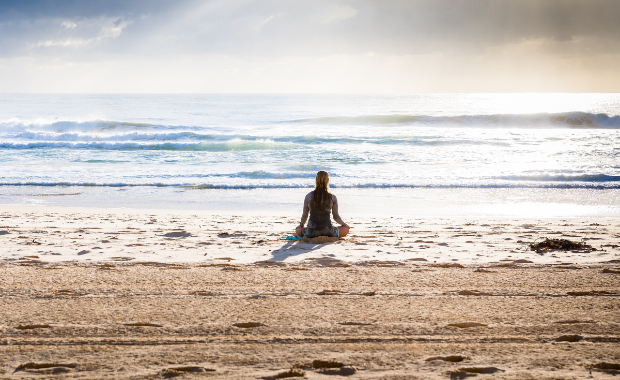Life
3 Ways to Instil Mindfulness and Peace in Your Daily Life

Sometimes, we might feel like our life is rushing through, overloaded with duties and responsibilities. Life’s hurdles make it appear like it is more of a chore, and ‘living in the moment’ seems like a tough business. Especially in 2020, ever since the undesired Covid-19 virus has turned the world upside down, finding peace, calm, and happiness amongst all the chaos can be tricky.
However, we can learn how to dodge these bullets and shun the constant need to achieve success by following some steps. As the adage goes, “The pursuit of inner peace is more important than the search for happiness or success.” We must give time for ourselves and find the inner calm to move forward.
In this article, we have mentioned three ways by which you can teach these values. Read on!
1. Meditation
By now, it is safe to assume that meditation has a plethora of health and psychological benefits. Some of these include decrement in anxiety, depressive thoughts, and reduced cortisol levels. If work or your personal life has you stressed out, meditating can go a long way in bringing you peace and calm.
It’s a method where you can spend a silent period in concentration and smooth out the jumbled thoughts making a mess in your head. One of the best things about meditation is; you can practice it anywhere, whether you are waiting for an appointment at the doctor’s, traveling in a car or bus, or when you are sipping some evening tea on the balcony.
You can perform this technique by spending a short time of ten to fifteen minutes in a simple seated stance, with your eyes closed. Follow that up with some steady inhalation and exhalations before you open your eyes again. If you are new to this whole topic, you can follow a guided meditation video with a calming background soundtrack on YouTube to lull you into a blissful state of mind.
“Empty your mind, be formless, shapeless – like water. Now you put water into a cup, it becomes the cup, you put water into a bottle, it becomes the bottle, you put it in a teapot, it becomes the teapot. Now water can flow or it can crash. Be water, my friend.” – Bruce Lee
2. Gratefulness and Contribution
The concept of being grateful can help anyone achieve satisfaction and a happy state of mind. It allows you to understand and appreciate your blessings instead of distressing over the things you don’t have. It shows how you are luckier than the people who have it worse and eliminates the idea of self-pity, which is indeed destructive to our minds.
You can practice gratefulness by listing down all the skills, loving people, and material possessions you have. Constantly go through that list to remind yourself about the positivity in your life.
You can also learn gratefulness by contributing to those in need. Take out some time to volunteer in a charity or pay a visit to an orphanage or nursing home. If you love animals, you can stop by an animal shelter or adopt a few abandoned pets!
Putting your time and energy into helping someone else gives you a sense of positivity, and you can indirectly help yourself. Doing something kind for someone without expecting anything in return is therapeutic in a way. While feeling at peace, you might also find your purpose in life!
3. Activity
Spending some time in leisure and activity with peers and family can also help you become more mindful and cheerful! Whether it is a long walk on the beach in the warm sand and mesmerizing sunset with a close one, a soothing, healthy family dinner, or a bike ride across the scenic part of town, it will give you a break from your usual routine and unclutter your headspace. These might sound a tad bit cliche, but they are effective. You can also indulge in some entertaining activities that involve communicating with other people. You can have a fun dance night, or attend a yoga class with some friends. You have creative liberty!
As long as those activities promote meaningful conversation and allow you to break free, they can drain out your stress and make you feel more optimistic.
“Do every act of your life as though it were the last act of your life.” – Joseph Goldstein
If you find peace in solitude, you can ride to a scenic destination like a lake or hill station (that is not crowded) and bask in beautiful sights of nature as you recollect positive thoughts and memories. According to experts, a good relationship with nature and its beauty has a deep connection with happiness.
Peace is a passive state of mind and not a destination that you have to chase. No matter what situation you are in, you can strategically let go of your stress and anxieties if you put in conscious effort. There are countless ways to achieve this great sense of mindfulness and harmony, and these three ways are a few of them. Practice the steps given in this article consistently, and you will find yourself calmer and collected in a short period!
Did You Know
How Skilled Migrants Are Building Successful Careers After Moving Countries
Behind every successful skilled migrant career is a mix of resilience, strategy, and navigating systems built for locals.

Moving to a new country for work is exciting, but it can also be unnerving. Skilled migrants leave behind familiar systems, networks, and support to pursue better job opportunities and a better future for their families. (more…)
Life
10 Research-Backed Steps to Create Real Change This New Year
This New Year could finally be the one where you break old patterns and create real, lasting change.

Every New Year, we make plans and set goals, but often repeat old patterns. (more…)
Life
9 Harsh Truths Every Young Man Must Face to Succeed in the Modern World
Before chasing success, every young man needs to face these 9 brutal realities shaping masculinity in the modern world.

Many young men today quietly battle depression, loneliness, and a sense of confusion about who they’re meant to be.
Some blame the lack of deep friendships or romantic relationships. Others feel lost in a digital world that often labels traditional masculinity as “toxic.”
But the truth is this: becoming a man in the modern age takes more than just surviving. It takes resilience, direction, and a willingness to grow even when no one’s watching.
Success doesn’t arrive by accident or luck. It’s built on discipline, sacrifice, and consistency.
Here are 9 harsh truths every young man should know if he wants to thrive, not just survive, in the digital age.
1. Never Use Your Illness as an Excuse
As Dr. Jordan B. Peterson often says, successful people don’t complain; they act.
Your illness, hardship, or struggle shouldn’t define your limits; it should define your motivation. Rest when you must, but always get back up and keep building your dreams. Motivation doesn’t appear magically. It comes after you take action.
Here are five key lessons I’ve learned from Dr. Peterson:
-
Learn to write clearly; clarity of thought makes you dangerous.
-
Read quality literature in your free time.
-
Nurture a strong relationship with your family.
-
Share your ideas publicly; your voice matters.
-
Become a “monster”, powerful, but disciplined enough to control it.
The best leaders and thinkers are grounded. They welcome criticism, adapt quickly, and keep moving forward no matter what.
2. You Can’t Please Everyone And That’s Okay
You don’t need a crowd of people to feel fulfilled. You need a few friends who genuinely accept you for who you are.
If your circle doesn’t bring out your best, it’s okay to walk away. Solitude can be a powerful teacher. It gives you space to understand what you truly want from life. Remember, successful men aren’t people-pleasers; they’re purpose-driven.
3. You Can Control the Process, Not the Outcome
Especially in creative work, writing, business, or content creation, you control effort, not results.
You might publish two articles a day, but you can’t dictate which one will go viral. Focus on mastery, not metrics. Many great writers toiled for years in obscurity before anyone noticed them. Rejection, criticism, and indifference are all part of the path.
The best creators focus on storytelling, not applause.
4. Rejection Is Never Personal
Rejection doesn’t mean you’re unworthy. It simply means your offer, idea, or timing didn’t align.
Every successful person has faced rejection repeatedly. What separates them is persistence and perspective. They see rejection as feedback, not failure. The faster you learn that truth, the faster you’ll grow.
5. Women Value Comfort and Security
Understanding women requires maturity and empathy.
Through books, lectures, and personal growth, I’ve learned that most women desire a man who is grounded, intelligent, confident, emotionally stable, and consistent. Some want humor, others intellect, but nearly all want to feel safe and supported.
Instead of chasing attention, work on self-improvement. Build competence and confidence, and the rest will follow naturally.
6. There’s No Such Thing as Failure, Only Lessons
A powerful lesson from Neuro-Linguistic Programming: failure only exists when you stop trying.
Every mistake brings data. Every setback builds wisdom. The most successful men aren’t fearless. They’ve simply learned to act despite fear.
Be proud of your scars. They’re proof you were brave enough to try.
7. Public Speaking Is an Art Form
Public speaking is one of the most valuable and underrated skills a man can master.
It’s not about perfection; it’s about connection. The best speakers tell stories, inspire confidence, and make people feel seen. They research deeply, speak honestly, and practice relentlessly.
If you can speak well, you can lead, sell, teach, and inspire. Start small, practice at work, in class, or even in front of a mirror, and watch your confidence skyrocket.
8. Teaching Is Leadership in Disguise
Great teachers are not just knowledgeable. They’re brave, compassionate, and disciplined.
Teaching forces you to articulate what you know, and in doing so, you master it at a deeper level. Whether you’re mentoring a peer, leading a team, or sharing insights online, teaching refines your purpose.
Lifelong learners become lifelong leaders.
9. Study Human Nature to Achieve Your Dreams
One of the toughest lessons to accept: most people are self-interested.
That’s not cynicism, it’s human nature. Understanding this helps you navigate relationships, business, and communication more effectively.
Everyone has a darker side, but successful people learn to channel theirs productively into discipline, creativity, and drive.
Psychology isn’t just theory; it’s a toolkit. Learn how people think, act, and decide, and you’ll know how to lead them, influence them, and even understand yourself better.
Final Thoughts
The digital age offers endless opportunities, but only to those who are willing to take responsibility, confront discomfort, and keep improving.
Becoming a man today means embracing the hard truths most avoid.
Because at the end of the day, success isn’t about luck. It’s about who you become when life tests you the most.
Change Your Mindset
The Four Types of Happiness: Which One Are You Living In?
Most people chase success only to find emptiness, this model reveals why true happiness lies somewhere else.

In a world driven by rapid technological growth and constant competition, many people unknowingly trade joy for achievement. (more…)
-

 Shift Your Mindset4 weeks ago
Shift Your Mindset4 weeks ago11 E’s That Define Every Great Leader And Why Most People Miss Them
-

 Did You Know4 weeks ago
Did You Know4 weeks agoThe Success Patterns You Inherited (And Didn’t Notice)
-

 Entrepreneurs3 weeks ago
Entrepreneurs3 weeks agoThe Essential Skills Every Entrepreneur Needs In 2026
-

 Business4 weeks ago
Business4 weeks agoThe Hidden Money Pit in Your Operations (and How to Use It)
-

 Change Your Mindset2 weeks ago
Change Your Mindset2 weeks agoHow to Turn Your Mind Into Your Greatest Asset (Instead of Your Enemy)
-

 Change Your Mindset2 weeks ago
Change Your Mindset2 weeks agoThe Silent Skill That Makes People Respect You Instantly
-

 Life2 weeks ago
Life2 weeks ago10 Research-Backed Steps to Create Real Change This New Year
-

 Tech1 week ago
Tech1 week agoWhat’s in a Name? How to Get Your Domain Right

























